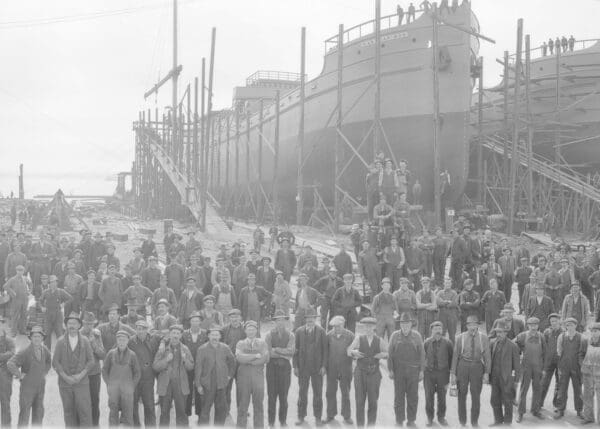01. Shipyard History
History
Charleston Naval Base was located on the west bank of the Cooper River in North Charleston, South Carolina, between 1901 and 1996.
After the Civil War, in 1890, Charleston was awarded a contract to construct the naval yard. Initially the shipyard was used to repair ships, but eventually ship construction took place. During WWI, 18 new ships were constructed and 160 vessels were altered or repaired.
During WWII, Charleston Naval Base provided construction, repair and logistic support to the operating forces while thousands of soldiers, sailors and airmen passed through its military facilities on their way to war. Between 1944 and 1958, the Charleston Naval Base was active in the testing and refitting of submarines for the Cold War, as well as overhauling mothballed ships for use in the Korean War and the Vietnam War.
In 1983, the Naval Base was the third largest naval home port in the United States, employing roughly 36,700 people, including 23,500 Navy and Marine Corps personnel and 13,200 civilians. From that time until the time of its closing, the Naval Base was used for maintaining surface ships, overhauling nuclear submarines and providing supplies and support to the U.S. Navy. In 1996, Charleston Naval Base was closed due to budget cuts.
Today, parts of the base and dry docks have been leased out to various government and private businesses and community parks have been established on its grounds.
Charleston Naval Base Shipyard History at a Glance
- Other Names: The Navy Yard, Charleston Navy Yard, Naval Shipyard Charleston, Charleston Naval Base and Shipyard
- Location: Located on the west bank of the Cooper River in North Charleston, South Carolina
- Owner(s): Federal Government and private organizations
- Years of Operation: 1901 – 1996
- Wartime Operations: World War I (WWI), World War II (WWII), Cold War, Korean War and the Vietnam War
- Number of Employees: 36,700 employees in 1983
- Size of Shipyard: 1,575 acres
- Noteworthy Ships: USS Tillman, USS Proteus, USS Tidewater, USS Bryce Canyon, USS Nicholson
- Noteworthy Personnel: Captain Edwin Longnecker
- Types of Ships Built/Serviced: Submarines, dredgers, patrol cutters, gunboats, submarine chasers, tugboats, barges, paddle-wheel steamboats, ferry boats, destroyers, minesweepers, submarine tenders, destroyer tenders
Many workers at Charleston Naval Base were potentially exposed to asbestos. Workers’ loved ones may have also experienced secondhand exposure. As a result, many people developed asbestos-related diseases, such as asbestosis, asbestos lung cancer, and pleural and peritoneal mesothelioma. People who developed an asbestos-related disease may be eligible for compensation.
Notable Ships Built and Repaired
Active for more than 90 years, there were several noteworthy ships that were built, repaired or modernized at Charleston Naval Base. This includes the USS Proteus, which had one of the largest conversions ever done to a ship and the USS Bryce Canyon, which was active for more than 30 years.
Asbestos was used in shipbuilding for several decades at the Charleston Naval Base. This put many workers at risk for developing asbestos-related diseases.
USS Proteus
USS Proteus was a submarine tender that was laid down in 1941 at the Moore Shipbuilding and Dry Dock Company in Oakland, California. She tended to the submarine force that was battling the Japanese during WWII. After the war, USS Proteus was homeported in New London, Connecticut and was decommissioned in 1947.
In 1960, in response to the Cold War, USS Proteus was moved into dry dock in Charleston Naval Base. She was cut amidships and a 44-foot plug was installed in sections to accommodate the repair and transport of missiles. This was one of the largest ship conversion jobs ever attempted.
She returned to Charleston in 1963 and 1964. Some of USS Proteus’s missions after that included assisting U.S. Navy Seabees with the construction of a massive tent city to house more than 100,000 refugees in the South West Pacific. She also helped dig out the Subic Bay Naval Base and nearby towns after the eruption of Mount Pinatubo in the Philippines in 1991. She was decommissioned in 1992.
Asbestos was a key material used in ship construction, repair and modernization during the time the USS Proteus was constructed and for most of her time in service. Anyone working on the USS Proteus risked developing mesothelioma or other asbestos-related diseases.
USS Bryce Canyon
USS Bryce Canyon was a destroyer tender that was built in Charleston Naval Base in 1945. In 1951, she was deployed for the Korean War. This was the first of a series of “West Pacs,” alternating with West Coast duty, that marked USS Bryce Canyon’s almost 31-year career.
She was decommissioned in 1981 and scrapped for metal in 1982.
From the time she was built to the time she was decommissioned and scrapped, asbestos was being used heavily in shipbuilding and repairs. Crewmembers and workers on the USS Bryce Canyon would have been at risk of developing asbestos-related diseases such as mesothelioma at any point during the ship’s lifetime.
02. Shipyard Asbestos Use
Asbestos Use at Charleston Naval Base
Because asbestos is heat resistant and durable, it was commonly used in ship construction. Raw asbestos and various asbestos products were used throughout ships to help prevent fires. Use of the mineral also helped control heat emitted by machinery, such as boilers and engines.
Charleston Naval Base was an active worksite during 1901 – 1996, when asbestos was also commonly used on ships. Workers at Charleston Naval Base used asbestos as insulation in walls, around pipes, in boilers and elsewhere on ships. As a result, workers came in contact with many products that put them at risk of asbestos-related diseases.
Asbestos Exposure at Charleston Naval Base
Civilian workers and military service members worked in shipyards and aboard ships. From the 1930s to the 1980s, tons of asbestos were used in shipyards and shipbuilding. As a result, U.S. Navy veterans and civilian workers at Charleston Naval Base faced a high risk of asbestos exposure and developing malignant mesothelioma cancer.
Those who helped maintain or repair submarines, gunboats, submarine chasers, destroyers, minesweepers, submarine tenders and destroyer tenders also faced these risks. The heavy use of the dangerous mineral, along with poor ventilation on ships, led to frequent asbestos exposure. For example, insulators were exposed through installation and maintenance work.
Although asbestos use ceased at shipyards by the 1980s, workers and visitors may still risk exposure today. Asbestos materials may still be found on ships built before the 1980s and older equipment at shipyards. Working with asbestos insulation, repairing old boilers and other shipyard duties put individuals at risk of exposure.
03. Asbestos Lawsuits
Asbestos Lawsuits and Settlements
People who worked on ships at Charleston Naval Base are at risk of developing asbestos cancer or other related diseases. After a diagnosis, these shipyard workers have compensation options.
Victims can be compensated by the companies that exposed them to asbestos. Their compensation options depend on the status of that company. Victims can work with a mesothelioma lawyer to secure payment from a lawsuit, settlement, trust fund and/or VA claim (or a combination of these types of claims).
Holding Asbestos Companies Responsible
Some companies that produced asbestos products are still viable. This means the company hasn’t filed for bankruptcy. Thus, individuals can file lawsuits against that company. These lawsuits could end in verdicts or settlements.
For example, Flowserve U.S. Inc. provided asbestos-containing valves for ships that workers installed and repaired. The insulation, gaskets and packing for these valves contained asbestos and put workers at risk of developing mesothelioma.
ITT Corporation, another viable company, wrongfully exposed people to asbestos through the sale of gaskets at Charleston Naval Base. As a result, victims filed successful lawsuits against these companies.
04. Filing Asbestos Claims
Asbestos Company Trusts
Since the 2000s, more than 100 companies have filed bankruptcy after exposing people to asbestos and the resultant lawsuits. Many of these asbestos companies had to create trust funds to compensate current and future victims of asbestos-related diseases.
Asbestos was a common occupational hazard for shipyard workers. If a shipyard worker developed an asbestos-related disease, that person can file an asbestos claim with that manufacturer’s trust.
Asbestos Company Trust Funds and Eligible Years of Employment
The following companies provided asbestos products to Charleston Naval Base. After facing many asbestos lawsuits and exposing innocent people to asbestos, these companies filed for bankruptcy and created trusts to pay victims. If an individual worked at Charleston Naval Base and developed a disease such as mesothelioma, they may be able to file a claim against these companies’ trusts.
| Asbestos Trust Funds & Eligible Years of Employment | ||
|---|---|---|
| Asbestos Company Name | Eligibility Start Date | Eligibility End Date |
| A.P. Green | 1/1/1964 | 1/2/1968 |
| Armstrong WI Trust | 4/22/1942 | 12/31/1982 |
| Babcock & Wilcox | 1/1/1941 | 12/31/1982 |
| Combustion Engineering | 1/1/1926 | 12/31/1982 |
| Fibreboard | 1/1/1928 | 12/31/1982 |
| Flexitallic | 1/1/1941 | 12/31/1982 |
| G-I Holdings (GAF) | 1/6/1971 | 12/31/1982 |
| Keene Corporation | 1/1/1951 | 12/31/1982 |
| Owens Corning | 1/1/1948 | 12/31/1982 |
| Pittsburgh Corning | 1/1/1969 | 12/31/1982 |
| Plant Insulation | 1/1/1939 | 12/31/1970 |
| United States Gypsum | 1/1/1964 | 1/2/1968 |
| Yarway | 2/20/1979 | 12/31/1982 |




